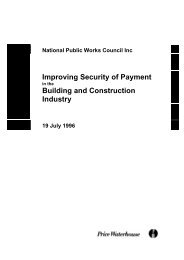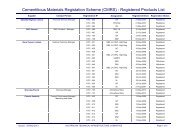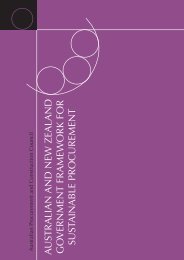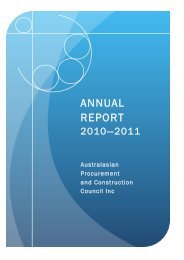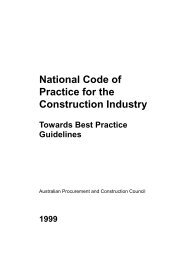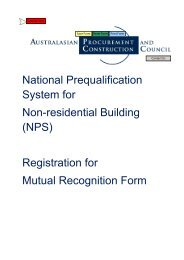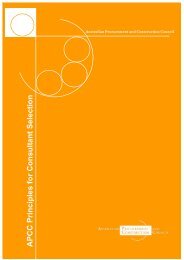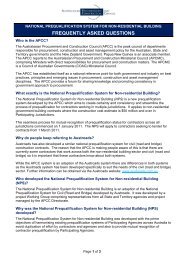ESD design guide for Australian Government buildings: Edition 2
ESD design guide for Australian Government buildings: Edition 2
ESD design guide for Australian Government buildings: Edition 2
Create successful ePaper yourself
Turn your PDF publications into a flip-book with our unique Google optimized e-Paper software.
esd opportunities in building<br />
OPPORTUNITY 9<br />
water conservation<br />
<strong>Government</strong> Buildings – Possible<br />
Water Savings<br />
‘The potential savings available from<br />
<strong>Australian</strong> <strong>Government</strong> <strong>buildings</strong><br />
and operations are between 4,296<br />
and 7,405 ML/year. This is based<br />
on savings assumptions by building<br />
type developed through the desktop<br />
study and site assessments.<br />
Achieving these savings would cost<br />
between $8.2 and $14.6 million<br />
based on cost assumptions derived<br />
from empirical case studies in the<br />
literature.’ 43<br />
Figure 39: Water reduction methods 42 , ISF.<br />
A dual flush toilet replacing a<br />
single flush unit in an office<br />
building will save approximately<br />
360 litres each working day (90<br />
kL per year) in a female toilet,<br />
an annual financial saving from<br />
potable water alone of about $90<br />
or more. For a male toilet the<br />
saving will be about 40kL/year.<br />
For the Edmund Barton building,<br />
with approximately 2,800 staff, this<br />
would mean an annual saving of<br />
more than 9 ML, or $11,000 <strong>for</strong> a<br />
A recent study by the Institute <strong>for</strong><br />
Sustainable Futures showed that an<br />
80% reduction of potable water and<br />
90% of sewage was possible in a<br />
commercial building<br />
Opportunities <strong>for</strong> water reduction are<br />
as follows (these are discussed in<br />
greater detail below):<br />
• management and monitoring,<br />
• leak avoidance,<br />
• efficient fixtures and fittings,<br />
• water sensitive landscaping and<br />
• source substitution.<br />
Figure 40: Water image, stock.XCHNG.<br />
Efficient fixtures and fittings<br />
Water efficiency labels are being<br />
Management and monitoring<br />
Regular monitoring of meters<br />
and sub-meters, either manually<br />
or by connection to the Building<br />
introduced <strong>for</strong> many water-using<br />
appliances. Specification of efficient<br />
fixtures and fittings (as noted below)<br />
can reduce water wastage.<br />
Management System. This is<br />
particularly useful in establishing<br />
base flow rates and then identifying<br />
leaks when water use exceeds normal<br />
variability ranges.<br />
Toilets and urinals<br />
• Toilet and urinal adjustment<br />
– adjust floater to use minimal<br />
water<br />
• 3/ 4.5L dual flush toilets<br />
Leak avoidance<br />
• Urinal flush controls – sensors<br />
• Report of leaks to building<br />
management - building occupants<br />
should be made aware of where<br />
and to whom they can report any<br />
leaks. It is important to promptly fix<br />
any reported leakages <strong>for</strong> positive<br />
feedback.<br />
• Waterless Urinals<br />
Showers<br />
• Flow regulators – need good advice<br />
on type as some may result in an<br />
inadequate shower<br />
• AAA or AAAA showerheads – made<br />
• Regular inspections of toilets,<br />
urinals, taps and showers.<br />
to increase pressure so as to still<br />
have a good shower<br />
Taps<br />
• Flow restrictors <strong>for</strong> taps and tap<br />
aerators<br />
of under four years.’<br />
• Automatic cut-off and sensor<br />
‘In a busy public building, the<br />
saving from a dual flush toilet<br />
operated taps<br />
retrofit could be more than 1 kL per<br />
day per toilet, or about 400 kL/year<br />
<strong>for</strong> a building open every day of<br />
the year. The cost of retrofitting<br />
dual flush toilets depends upon<br />
the plumbing changes and<br />
redecorating that would be<br />
required. It can range from $250 to<br />
41 Berry T., Edgerton N., Milne G., Jha M. and White<br />
S. (2004) Feasibility Study <strong>for</strong> a Policy on Water in<br />
<strong>Government</strong> Operations, ISF, Sydney, July 2004.)<br />
p. 41-42.<br />
42 Chanan, V., White, S., Jha, M., & Howe, C. 2003,<br />
‘Sustainable Water Management in Commercial<br />
Office Buildings’ Innovations in Water: Ozwater<br />
Convention & Exhibition, Perth, 6-10 April 2003.<br />
43 Berry T., Edgerton N., Milne G., Jha, M. and White<br />
S. 2004, Feasibility Study <strong>for</strong> a Policy on Water in<br />
<strong>Government</strong> Operations, ISF, Sydney, July 2004.)<br />
<strong>ESD</strong> DESIGN GUIDE FOR AUSTRALIAN GOVERNMENT BUILDINGS 031


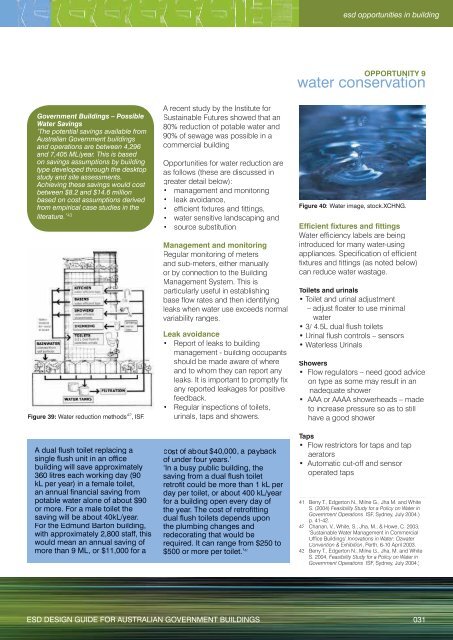
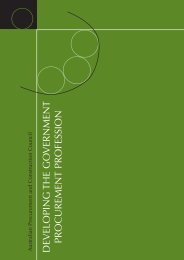
![NATIONAL COST ADJUSTMENT PROVISION EDITION 2 [NCAP2]](https://img.yumpu.com/48266135/1/184x260/national-cost-adjustment-provision-edition-2-ncap2.jpg?quality=85)
